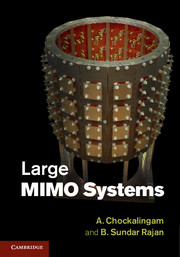Book contents
- Frontmatter
- Dedication
- Contents
- Preface
- Acknowledgments
- Abbreviations
- Notation
- 1 Introduction
- 2 Large MIMO systems
- 3 MIMO encoding
- 4 MIMO detection
- 5 Detection based on local search
- 6 Detection based on probabilistic data association (PDA)
- 7 Detection/decoding based on message passing on graphical models
- 8 Detection based on MCMC techniques
- 9 Channel estimation in large MIMO systems
- 10 Precoding in large MIMO systems
- 11 MIMO channel models
- 12 Large MIMO testbeds
- Author index
- Subject index
- References
2 - Large MIMO systems
Published online by Cambridge University Press: 18 December 2013
- Frontmatter
- Dedication
- Contents
- Preface
- Acknowledgments
- Abbreviations
- Notation
- 1 Introduction
- 2 Large MIMO systems
- 3 MIMO encoding
- 4 MIMO detection
- 5 Detection based on local search
- 6 Detection based on probabilistic data association (PDA)
- 7 Detection/decoding based on message passing on graphical models
- 8 Detection based on MCMC techniques
- 9 Channel estimation in large MIMO systems
- 10 Precoding in large MIMO systems
- 11 MIMO channel models
- 12 Large MIMO testbeds
- Author index
- Subject index
- References
Summary
Large MIMO systems are systems which use tens to hundreds of antennas in communication terminals. Depending on the application scenario, different MIMO system configurations are possible. These include point-to-point MIMO and multiuser MIMO configurations. In multiuser MIMO, point-to-multipoint (e.g., downlink in cellular systems), and multipoint-to-point (e.g., uplink in cellular systems) configurations are common. In a point-to-point communication scenario (Fig. 1.1), the number of transmit antennas nt at the transmitter and the number of receive antennas nr at the receiver can be large. A typical application scenario for a point-to-point large MIMO configuration is providing high-speed wireless backhaul connectivity between BSs using multiple antennas at each BS. Since space constraint need not be a major concern at the BSs, a large number of antennas can be used at both the transmit and receive BSs in this application scenario.
In multiuser MIMO (Fig. 1.2), the communication is between a BS and multiple user terminals. These user terminals can be small devices like mobile/smart phones or medium sized terminals like laptops, set-top boxes, TVs, etc. In mobile applications where mobile/smart phones and personal digital assistants are the user terminals, only a limited number of antennas can be mounted on them because of space constraints. However, in applications involving user terminals like TVs, set-top boxes, and laptops a larger number of antennas can be used on the user terminal side as well.
- Type
- Chapter
- Information
- Large MIMO Systems , pp. 16 - 24Publisher: Cambridge University PressPrint publication year: 2014
References
- 2
- Cited by

